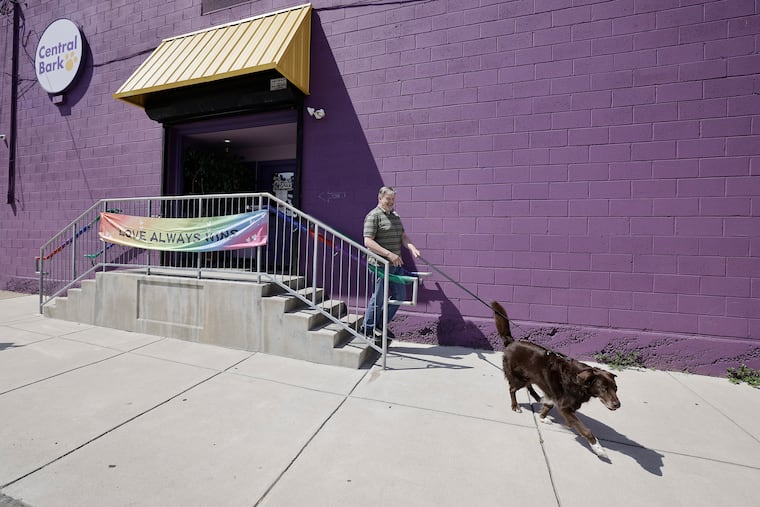Humans are back to work and social events. Their pups are getting anxious.
The boom is just one byproduct of the surge in dog and other pet adoptions that occurred during the pandemic.

When the Providence Animal Center introduced a new separation-anxiety class this month, the staff knew some people would be interested, having listened to the worries of dog owners as the pandemic relented and pets were being left home alone more often.
But the Media, Delaware County, pet adoption and training center didn’t anticipate just how popular the course would be: The June session quickly sold out, without any promotion, said Justina Calgiano, director of advancement and public relations.
The pup owners who enrolled “might be going back to work sometimes. They might have a bigger social schedule than they had before,” said Calgiano, noting that the center is offering the course again in July, with most spots already filled. “There was kind of a natural need.”
The training’s popularity is just one byproduct of the surge in pet adoptions that occurred during the pandemic.
Now, more than two years since COVID-19 hit, an increasing number of people are returning to schedules that take them away from home or bring them — and their pets — into contact with others: Remote work has turned into hybrid work, with some folks required to be in the office at least one or two days a week. Social plans and summer vacations may have become more frequent.
For dogs, that means fewer nights spent snuggled on the couch with their humans, busier streets on walks and outings, and a greater amount of time spent home alone — or watched by strangers — as their owners venture back into the world more often.
For vets, doggie day-care owners, canine trainers, and others in the pet business across the country, it has meant a flood of new clients — nearly 1 in 5 households adopted a dog or cat during the pandemic — and an increased appetite for behavior services to address everything from separation anxiety to leash reactivity to poor socialization.
Each phase of the pandemic has brought an adjustment for animals, said Carlo Siracusa, associate professor of clinical animal behavior at the University of Pennsylvania’s School of Veterinary Medicine.
“Look at the reality from your dog’s perspective: It hasn’t been easy for you,” said Siracusa, who is also the director of Ryan Veterinary Hospital’s Companion Animal Behavior Medicine service. “It hasn’t been easy for your dogs.”
» READ MORE: Philly animal rescues overwhelmed as families return their pandemic pups en masse
From his perspective — seeing the most severe cases, ones that require veterinary attention — the biggest problem is not separation anxiety, he said, but trouble with canine reactivity. With increased foot and car traffic, streets are more crowded and noisy than during previous periods of the pandemic, he said, and many so-called COVID puppies have never experienced that before, causing them to lunge into traffic or at passersby.
Many people put off addressing these issues until recently, perhaps prompted by looming changes to their work or social schedules, he said.
“It has absolutely overwhelmed us,” he said, noting his veterinary practice is short-staffed and the wait list for appointments is usually long.
Central Bark, a Grays Ferry dog day care that also offers training and overnight boarding, is at capacity and looking to expand into a second location to accommodate the rising demand, said owner Portia Scott.
Scott said she sees, too, that dogs — including her mutt, Bowie — are more reactive and anxious, especially in public, set off by so many cars and people. That can exacerbate the anxiety of owners, who may already be stressed by the return to regular socialization, she said. Dogs can sense their owners’ mind-set, she said, and behave accordingly.
“There’s definitely a level of anxiety as much in the humans as the dogs,” said Scott, who adopted Bowie in December 2019. “Having a puppy during the pandemic was just such a wonderful crutch,” one that owners can no longer rely on amid more hectic schedules.
At Opportunity Barks Training and Behavior, owner Leigh Siegfried said interest peaked last summer and has remained consistent since, with a noticeable increase in reactivity issues among pups acclimating to busier outdoor spaces. Separation anxiety, meanwhile, she said, is addressed in private, one-on-one sessions.
The drop-off, day-training puppy programs at Opportunity Barks — which operates studios in Old City, East Falls, and Quakertown — have been especially popular throughout the pandemic, taking a stressor off owners’ plates.
“I definitely felt like a lot more people were happy to be like: ‘Help me with this, if you’d like to do the heavy lifting,’” Siegfried said.
For those without the resources to seek professional training, Siegfried said she recommends simple, at-home exercises, focusing on one aspect of a dog’s behavior at a time.
“Be kind to yourself, because I think that dog ownership is ample grounds for self-flagellation if you let it go that way,” she said. Even if it’s just through free online training videos, “seek help. There’s so many resources out there.”